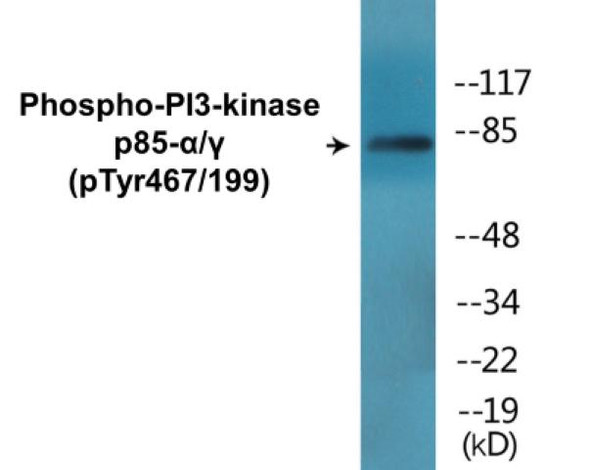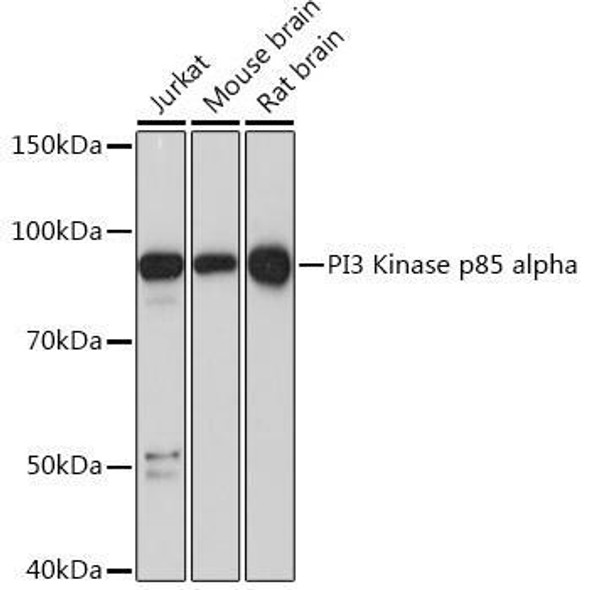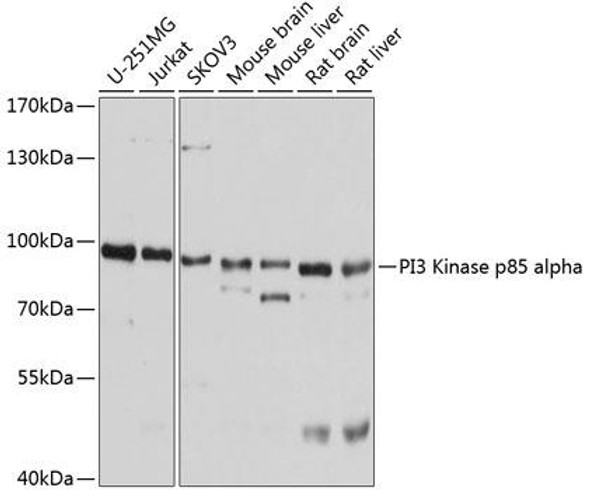Description
PI3-kinase p85-alpha/gamma Colorimetric Cell-Based ELISA Kit
The PI3 Kinase p85 Alpha/Gamma Colorimetric Cell-Based ELISA Kit is a cutting-edge tool for researchers looking to accurately measure levels of PI3 Kinase p85 Alpha and Gamma in cell lysates. This kit boasts high sensitivity and specificity, ensuring precise and reproducible results for a variety of experimental applications.PI3 Kinase p85 Alpha and Gamma are key regulatory components in the PI3 Kinase pathway, playing essential roles in cell growth, survival, and proliferation.
Dysregulation of this pathway has been implicated in various diseases, including cancer, diabetes, and autoimmune disorders, underscoring the importance of studying these proteins as potential therapeutic targets.With the PI3 Kinase p85 Alpha/Gamma Colorimetric Cell-Based ELISA Kit, researchers can delve deeper into the complex mechanisms governing cell signaling and disease pathogenesis, paving the way for innovative new treatments and diagnostic strategies.
| Product Name: | PI3-kinase p85-alpha/gamma Colorimetric Cell-Based ELISA |
| Product Code: | CBCAB00811 |
| ELISA Type: | Cell-Based |
| Target: | PI3-kinase p85-alpha/gamma |
| Reactivity: | Human, Mouse, Rat |
| Dynamic Range: | > 5000 Cells |
| Detection Method: | Colorimetric 450 nmStorage/Stability:4°C/6 Months |
| Format: | 96-Well Microplate |
The PI3-kinase p85-alpha/gamma Colorimetric Cell-Based ELISA Kit is a convenient, lysate-free, high throughput and sensitive assay kit that can detect PI3-kinase p85-alpha/gamma protein expression profile in cells. The kit can be used for measuring the relative amounts of PI3-kinase p85-alpha/gamma in cultured cells as well as screening for the effects that various treatments, inhibitors (ie siRNA or chemicals), or activators have on PI3-kinase p85-alpha/gamma.
Qualitative determination of PI3-kinase p85-alpha/gamma concentration is achieved by an indirect ELISA format. In essence, PI3-kinase p85-alpha/gamma is captured by PI3-kinase p85-alpha/gamma-specific primary antibodies while the HRP-conjugated secondary antibodies bind the Fc region of the primary antibody. Through this binding, the HRP enzyme conjugated to the secondary antibody can catalyze a colorimetric reaction upon substrate addition. Due to the qualitative nature of the Cell-Based ELISA, multiple normalization methods are needed:
| 1. | A monoclonal antibody specific for human GAPDH is included to serve as an internal positive control in normalizing the target absorbance values. |
| 2. | Following the colorimetric measurement of HRP activity via substrate addition, the Crystal Violet whole-cell staining method may be used to determine cell density. After staining, the results can be analysed by normalizing the absorbance values to cell amounts, by which the plating difference can be adjusted. |
| Database Information: | Gene ID: 5295/8503, UniProt ID: P27986/Q92569, OMIM: 171833/606076, Unigene: Hs.132225/Hs.604502/Hs.655387 |
| Gene Symbol: | PIK3R1/PIK3R3 |
| Sub Type: | None |
| UniProt Protein Function: | PIK3R1: regulatory subunit of phosphoinositide-3-kinase. Mediates binding to a subset of tyrosine-phosphorylated proteins through its SH2 domain. Acts as an adapter, mediating the association of the p110 catalytic unit of the alpha, beta and delta enzymes to the plasma membrane, where p110 phosphorylates inositol lipids. May play an additional role in the regulation of the actin cytoskeleton. Necessary for the insulin-stimulated increase in glucose uptake and glycogen synthesis in insulin-sensitive tissues. Its SH2 domains interacts with the YTHM motif of phosphorylated INSR in vitro. Defects in PIK3R1 are a cause of severe insulin resistance. Four alternatively spliced isoforms have been described. |
| UniProt Protein Details: | Protein type:Motility/polarity/chemotaxis; Enzyme, regulatory subunit; Kinase, lipid Chromosomal Location of Human Ortholog: 5q13.1 Cellular Component: membrane; cytoplasm; plasma membrane; intercellular junction; nucleus; cytosol; phosphoinositide 3-kinase complex Molecular Function:insulin binding; insulin-like growth factor receptor binding; protein binding; ErbB-3 class receptor binding; insulin receptor substrate binding; neurotrophin TRKA receptor binding; phosphoinositide 3-kinase binding; phosphoinositide 3-kinase regulator activity; transcription factor binding; transmembrane receptor protein tyrosine kinase adaptor protein activity; protein phosphatase binding; insulin receptor binding Biological Process: negative regulation of osteoclast differentiation; phosphoinositide 3-kinase cascade; nerve growth factor receptor signaling pathway; viral reproduction; NFAT protein import into nucleus; positive regulation of RNA splicing; regulation of phosphoinositide 3-kinase activity; protein amino acid phosphorylation; T cell receptor signaling pathway; positive regulation of glucose import; phosphoinositide phosphorylation; phospholipid metabolic process; positive regulation of transcription factor import into nucleus; epidermal growth factor receptor signaling pathway; platelet activation; fibroblast growth factor receptor signaling pathway; phosphoinositide-mediated signaling; protein stabilization; positive regulation of tumor necrosis factor production; negative regulation of cell-matrix adhesion; DNA damage response, signal transduction resulting in induction of apoptosis; insulin-like growth factor receptor signaling pathway; cellular response to insulin stimulus; induction of apoptosis via death domain receptors; B cell differentiation; T cell costimulation; phosphatidylinositol biosynthetic process; insulin receptor signaling pathway; innate immune response; cell glucose homeostasis; positive regulation of transcription from RNA polymerase II promoter; blood coagulation; vascular endothelial growth factor receptor signaling pathway; leukocyte migration; positive regulation of cell migration; negative regulation of apoptosis Disease: Agammaglobulinemia 7, Autosomal Recessive; Short Syndrome; Immunodeficiency 36 |
| NCBI Summary: | Phosphatidylinositol 3-kinase phosphorylates the inositol ring of phosphatidylinositol at the 3-prime position. The enzyme comprises a 110 kD catalytic subunit and a regulatory subunit of either 85, 55, or 50 kD. This gene encodes the 85 kD regulatory subunit. Phosphatidylinositol 3-kinase plays an important role in the metabolic actions of insulin, and a mutation in this gene has been associated with insulin resistance. Alternative splicing of this gene results in four transcript variants encoding different isoforms. [provided by RefSeq, Jun 2011] |
| UniProt Code: | P27986 |
| NCBI GenInfo Identifier: | 118572681 |
| NCBI Gene ID: | 5295 |
| NCBI Accession: | P27986.2 |
| UniProt Secondary Accession: | P27986,Q15747, Q4VBZ7, Q53EM6, Q8IXA2, Q8N1C5, B3KT19 D3DWA0, E7EX19, |
| UniProt Related Accession: | P27986 |
| Molecular Weight: | 42,838 Da |
| NCBI Full Name: | Phosphatidylinositol 3-kinase regulatory subunit alpha |
| NCBI Synonym Full Names: | phosphoinositide-3-kinase, regulatory subunit 1 (alpha) |
| NCBI Official Symbol: | PIK3R1 |
| NCBI Official Synonym Symbols: | p85; AGM7; GRB1; IMD36; p85-ALPHA |
| NCBI Protein Information: | phosphatidylinositol 3-kinase regulatory subunit alpha; PI3-kinase subunit p85-alpha; PI3K regulatory subunit alpha; ptdIns-3-kinase regulatory subunit alpha; phosphoinositide-3-kinase regulatory subunit; phosphatidylinositol 3-kinase-associated p-85 alpha; phosphatidylinositol 3-kinase 85 kDa regulatory subunit alpha; phosphatidylinositol 3-kinase, regulatory subunit, polypeptide 1 (p85 alpha) |
| UniProt Protein Name: | Phosphatidylinositol 3-kinase regulatory subunit alpha |
| UniProt Synonym Protein Names: | Phosphatidylinositol 3-kinase 85 kDa regulatory subunit alpha; PI3-kinase subunit p85-alpha; PtdIns-3-kinase regulatory subunit p85-alpha |
| UniProt Gene Name: | PIK3R1 |
| UniProt Entry Name: | P85A_HUMAN |
| Component | Quantity |
| 96-Well Cell Culture Clear-Bottom Microplate | 2 plates |
| 10X TBS | 24 mL |
| Quenching Buffer | 24 mL |
| Blocking Buffer | 50 mL |
| 15X Wash Buffer | 50 mL |
| Primary Antibody Diluent | 12 mL |
| 100x Anti-Phospho Target Antibody | 60 µL |
| 100x Anti-Target Antibody | 60 µL |
| Anti-GAPDH Antibody | 60 µL |
| HRP-Conjugated Anti-Rabbit IgG Antibody | 12 mL |
| HRP-Conjugated Anti-Mouse IgG Antibody | 12 mL |
| SDS Solution | 12 mL |
| Stop Solution | 24 mL |
| Ready-to-Use Substrate | 12 mL |
| Crystal Violet Solution | 12 mL |
| Adhesive Plate Seals | 2 seals |
The following materials and/or equipment are NOT provided in this kit but are necessary to successfully conduct the experiment:
- Microplate reader able to measure absorbance at 450 nm and/or 595 nm for Crystal Violet Cell Staining (Optional)
- Micropipettes with capability of measuring volumes ranging from 1 µL to 1 ml
- 37% formaldehyde (Sigma Cat# F-8775) or formaldehyde from other sources
- Squirt bottle, manifold dispenser, multichannel pipette reservoir or automated microplate washer
- Graph paper or computer software capable of generating or displaying logarithmic functions
- Absorbent papers or vacuum aspirator
- Test tubes or microfuge tubes capable of storing ≥1 ml
- Poly-L-Lysine (Sigma Cat# P4832 for suspension cells)
- Orbital shaker (optional)
- Deionized or sterile water
*Note: Protocols are specific to each batch/lot. For the correct instructions please follow the protocol included in your kit.
| Step | Procedure |
| 1. | Seed 200 µL of 20,000 adherent cells in culture medium in each well of a 96-well plate. The plates included in the kit are sterile and treated for cell culture. For suspension cells and loosely attached cells, coat the plates with 100 µL of 10 µg/ml Poly-L-Lysine (not included) to each well of a 96-well plate for 30 minutes at 37°C prior to adding cells. |
| 2. | Incubate the cells for overnight at 37°C, 5% CO2. |
| 3. | Treat the cells as desired. |
| 4. | Remove the cell culture medium and rinse with 200 µL of 1x TBS, twice. |
| 5. | Fix the cells by incubating with 100 µL of Fixing Solution for 20 minutes at room temperature. The 4% formaldehyde is used for adherent cells and 8% formaldehyde is used for suspension cells and loosely attached cells. |
| 6. | Remove the Fixing Solution and wash the plate 3 times with 200 µL 1x Wash Buffer for five minutes each time with gentle shaking on the orbital shaker. The plate can be stored at 4°C for a week. |
| 7. | Add 100 µL of Quenching Buffer and incubate for 20 minutes at room temperature. |
| 8. | Wash the plate 3 times with 1x Wash Buffer for 5 minutes each time. |
| 9. | Add 200 µL of Blocking Buffer and incubate for 1 hour at room temperature. |
| 10. | Wash 3 times with 200 µL of 1x Wash Buffer for 5 minutes each time. |
| 11. | Add 50 µL of 1x primary antibodies (Anti-PI3-kinase p85-alpha/gamma Antibody and/or Anti-GAPDH Antibody) to the corresponding wells, cover with Parafilm and incubate for 16 hours (overnight) at 4°C. If the target expression is known to be high, incubate for 2 hours at room temperature. |
| 12. | Wash 3 times with 200 µL of 1x Wash Buffer for 5 minutes each time. |
| 13. | Add 50 µL of 1x secondary antibodies (HRP-Conjugated AntiRabbit IgG Antibody or HRP-Conjugated Anti-Mouse IgG Antibody) to corresponding wells and incubate for 1.5 hours at room temperature. |
| 14. | Wash 3 times with 200 µL of 1x Wash Buffer for 5 minutes each time. |
| 15. | Add 50 µL of Ready-to-Use Substrate to each well and incubate for 30 minutes at room temperature in the dark. |
| 16. | Add 50 µL of Stop Solution to each well and read OD at 450 nm immediately using the microplate reader. |
(Additional Crystal Violet staining may be performed if desired – details of this may be found in the kit technical manual.)







